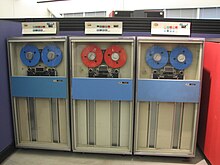
Back 9-track tape Dutch 9-spors magnetbånd NB 9-дорожечная лента Russian 9-доріжкова магнітна стрічка Ukrainian Băng ghi 9 đường Vietnamese
This article needs additional citations for verification. (January 2023) |


9-track tape is a format for magnetic-tape data storage, introduced with the IBM System/360 in 1964. The 1⁄2 inch (12.7 mm) wide magnetic tape media and reels have the same size as the earlier IBM 7-track format it replaced, but the new format has eight data tracks and one parity track for a total of nine parallel tracks. Data is stored as 8-bit characters, spanning the full width of the tape (including the parity bit). Various recording methods have been employed during its lifetime as tape speed and data density increased, including PE (phase encoding), GCR (group-coded recording), and NRZI (non-return-to-zero, inverted, sometimes pronounced "nur-zee"). Tapes come in various sizes up to 3,600 feet (1,100 m) in length.
The standard size of a byte was effectively set at eight bits with the S/360 and nine-track tape.
For over 30 years the format dominated offline storage and data transfer, but by the end of the 20th century it was obsolete, and the last manufacturer of tapes ceased production in early 2002,[1] with drive production ending the next year.[2]
- ^ "eMag Solutions LLC announces end-of-life plan for open reel (9-track) tape". eMag Solutions. 2001-12-17. Archived from the original on 2001-12-28. Retrieved 2016-03-19.
- ^ "Qualstar Bids Farewell to 9-Track Tape Drives". Business Wire. 2003-09-22. Archived from the original on 2016-01-17. Retrieved 2016-03-19.